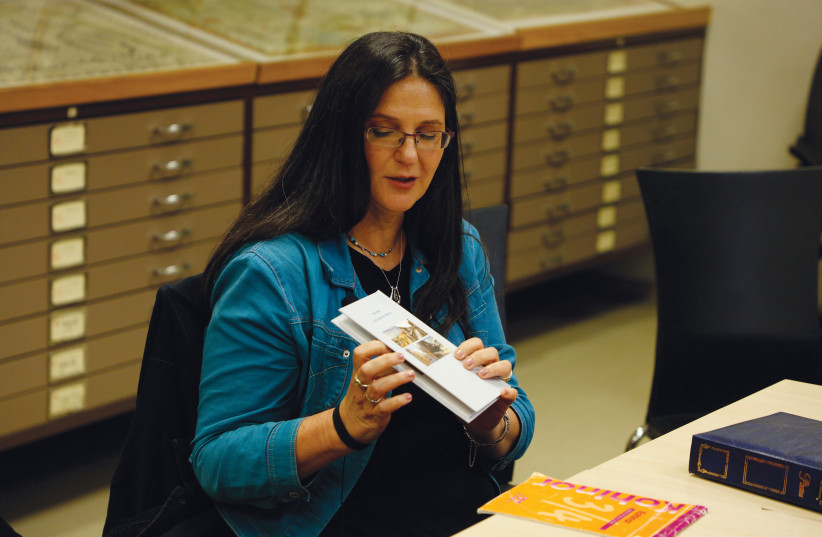Imagine being a 16-year-old “pigeoneer” in Israel’s War of Independence.
At a time when “hi-tech” was an unknown factor in Israeli life, 16-year-old Yehudit Entin volunteered for the Israel Army’s fledgling signal corps to send messages to troops not by computer-assisted technology as would be the case today – but by trusted pigeons.
Now, seventy-five years after the war, Entin’s daughter, Michal Ashin, reflects on her mother’s memorable poem, “The Pigeoneer,” about her wartime experience.
Ashin, a chemical engineer who worked for the Israel Electric Corporation for 27 years, also holds a Masters and Doctorate in public health from Ben-Gurion University of the Negev and lectures on the environment and health issues. But in addition to her professional work, she writes popular children’s books.
Fascinating children's tales
In fact, her third book, Tik Ha Pla-im Shel Savta (Grandma’s Wonderous Handbag) features stories that Yehudit used to tell her grandchildren, including fascinating tales about being a “pigeoneer” in the War of Independence.

“The first chapter (of my book),” Ashin explains, “was actually the poem my mother wrote. Every time she would come to visit, my kids would beg for her to tell her stories, like the ones about the messenger pigeons, and about 10 generations of family in Jerusalem… ”
These stories reflect what her mother referred to in her poem as “a beautiful era,” or as Ashin explains, “a more simple time.”
Yehudit Entin’s contribution to the War of Independence is part of the National Library of Israel’s ambitious Operation Diary project, and Matan Barzilai, the head of the library’s Archives & Special Collections, notes that the project includes archives of important personages in Israeli history, culture and society.
The project calls on the general public to join the library, notes Barzilai, “in documenting history, and tell the story of the State of Israel from a collective perspective.”
Searching for diaries from 1948
“To that end,” he adds, “we invited the public to search their attics, closets, cellars, or any other place where they might find diaries or other personal accounts from the 1948 era. This has succeeded beyond our expectations – to date, we’ve received almost 60 submissions from all over Israel and abroad as well.
“These diaries are amazing documents because they are descriptions of events as they are happening. This goes hand-in-hand with the newer approach to social history that recognizes personal experience as a vital part of historical documentation.”
Beyond her encounter with the pigeons, Entin’s story also sheds light on another fascinating link to Israel’s early history: she was born in Jerusalem to a family that was tenth generation Jerusalemites on her grandfather’s side and many generations on her grandmother’s side as well.
Her ancestors moved outside Jerusalem’s Old City walls sometime in the 19th century, thanks to the efforts of Sir Moses Montefiore, the British philanthropist who expanded the city’s boundaries with the new neighborhoods of Mishkenot Sha’ananim and Yemin Moshe, the latter known, of course, for its iconic windmill.
Ashin’s father, who grew up in Haifa, made aliyah in 1934 with his family by ship from Latvia.
Michal was born in Haifa. Her husband is a first-generation oleh from Uruguay and was a career officer in the Israel Air Force. The couple has four children: the oldest are twins, a boy and a girl, both now married, a 19-year-old son studying in a pre-army yeshiva program and a 16-year-old daughter in high school.
Ashin describes her mother as “very social, loved to help, was outgoing… ” So when the Haganah was looking for volunteers, it made sense, obviously, that 16-year-old Yehudit would eagerly come forward and volunteer.
“She took care of the pigeons,” says Ashin. “The point was to make the birds feel ‘at home,’ so that they would come back home. In the last years of her life, she wrote a memoir and told how she and her friend would dash between Jordanian sniper bullets to reach the Schneller compound.” (The site was a 19th-century German Protestant orphanage-turned British military compound, which finally became a Haganah base in the War of Independence).
In her memoir, Yehudit also wrote that the messenger pigeons could sometimes unfortunately deliver tragic news – like news that the Old City had been conquered or that Gush Etzion had fallen.
Yehudit “loved sports,” her daughter recalls, and was a member of Maccabi Hatzair, the Maccabi youth movement that focused on sports. “She competed in running, high-jump, and shot-put,” says Ashin. “She even won a silver medal for running. Her group coordinator was Eliyahu Sasson, who later became ambassador to Egypt, and her group leader was Yaakov Ben-Attar, who fell in battle at Gush Etzion.”
After the War of Independence, Yehudit worked in the youth department of the Jewish National Fund. She had studied French because her parents wanted her to study pharmacology in France, since no Israeli school offered it at the time. But in the end, she remained at the Jewish National Fund until she married, then moved to Haifa and worked as a secretary at Haifa University.
According to Barzilai, the library’s project is still ongoing. “The families that deposit diaries with the library,” he explains, “let us know if there are any confidentiality restrictions they wish to place on these precious records. The diaries will be catalogued and maintained in our state-of-the-art archives. Digital copies, where permission is granted, will be uploaded to the Library website.
“We are excited to provide these first-person historical accounts for the benefit of the generations to come.”
Those interested in the project should visit the library’s Operation Diary webpage at https://www.nli.org.il/en/at-your-service/who-we-are/projects/personal-diaries
